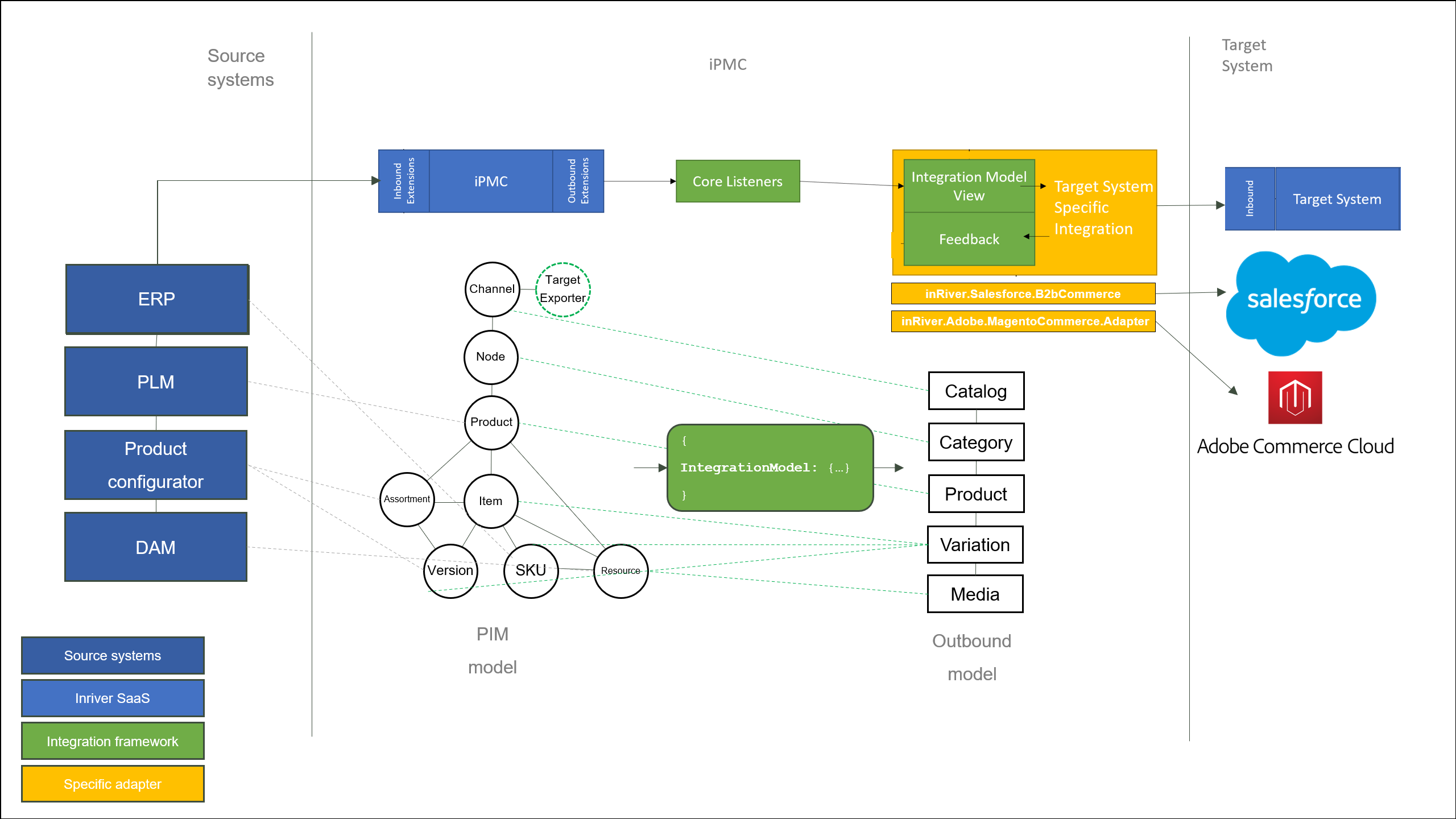Framework Overview
The Inriver Integration Framework represents a significant architectural improvement in how PIM integrations are designed and implemented. By decoupling standard adapters, the framework allows developers to focus more on integrating with the target system and less on the complexities of the Inriver platform itself.
This approach simplifies integration development by providing a standardized way to handle data mapping, channel configuration, and export management through well-defined entity types and JSON-based configuration.
Key Benefits
- Reduced integration complexity
- Standardized data mapping approach
- Focus on target system requirements
- Reusable integration patterns
- JSON-based configuration for flexibility
Framework Demonstration
This video demonstrates the Inriver Integration Framework in action, showing how it simplifies the integration process and provides a more focused approach to connecting with target systems.

Integration Framework Architecture
The Inriver Integration Framework architecture showing how it decouples standard adapters to focus on target system integration
ExportTarget Configuration
To specify how channels are exported, the framework sets up the entity type ExportTarget. This entity contains information specific to a channel being exposed through the framework. Each ExportTarget entity represents a unique integration endpoint and contains all the necessary configuration for that specific channel export.
The ExportTarget entity serves as the central configuration point for each integration, defining what data should be exported, how it should be transformed, and where it should be sent. This approach provides a clean separation of concerns between different export channels while maintaining consistency in the integration approach.
ExportTarget Key Components
- Channel-specific configuration settings
- Target system connection details
- Data transformation rules
- Export scheduling parameters
- Error handling and retry policies
JSON-Based Model Mapping
The PIM model is mapped using the integration_model of the integration framework. This is a JSON document that maps the Inriver model to the outbound model, providing a flexible and maintainable approach to data transformation.
The JSON mapping configuration allows for complex transformations and relationships to be defined declaratively, making it easier to understand and modify integration logic without changing code. This approach significantly reduces the development time for new integrations and makes maintenance more straightforward.
Integration Model JSON Configuration
Example JSON configuration used for mapping the PIM model to the outbound integration model
{
"IntegrationsMapping": {
"Product": {
"EntityTypeId": "Product",
"UniqueFieldTypeId": "ProductNumber"
},
"Variations": [
{
"EntityTypeId": "Item",
"UniqueFieldTypeId": "ItemNumber"
}
],
"Bundles": [],
"Catalog": {
"EntityTypeId": "Channel",
"UniqueFieldTypeId": "ChannelUniqueId"
},
"Category": {
"EntityTypeId": "ChannelNode",
"UniqueFieldTypeId": "ChannelNodeUniqueId"
},
"Media": {
"EntityTypeId": "Resource",
"UniqueFieldTypeId": "ResourceFilename"
},
"ExtendedAttributes": [],
"AttributeGroups": []
},
"RelationsConfiguration": {
"Associations": [],
"IgnoredLinkTypeIds": [],
"SoftLinksMapping": {},
"CategoryConditionalExclusions": []
},
"VariationsConfiguration": {
"StructuredData": {
"FieldTypeId": "",
"UniqueField": "",
"SortOrderField": ""
},
"FieldTypeIdForVariationGroupId": "",
"Variants": {
"GlobalVariants": [],
"FieldsetVariants": {},
"FieldTypeVariants": {}
}
}
}Understanding the Mapping Sections
IntegrationsMapping
The IntegrationsMapping section defines how core Inriver entities map to the target system's data model. Each entity type is configured with its unique identifier field, ensuring data integrity during synchronization. This mapping is crucial for maintaining relationships between different entity types across systems.
RelationsConfiguration
This section handles the complex relationships between entities, including associations, link types, and conditional exclusions. It provides fine-grained control over which relationships are exported and how they're represented in the target system. The SoftLinksMapping allows for flexible relationship handling when direct relationships aren't suitable.
VariationsConfiguration
Product variations are a critical aspect of many PIM implementations. This configuration section defines how variants are structured, sorted, and grouped. It supports multiple variation strategies including global variants that apply across all products, fieldset-specific variants, and field type variants for maximum flexibility.
Key Configuration Areas
- Entity type mappings with unique identifiers
- Relationship and association configurations
- Variation and variant handling rules
- Media and resource management settings
- Extended attribute definitions
Implementation Benefits
Reduced Complexity
By abstracting the Inriver-specific integration logic into a framework, developers can focus on understanding and implementing the target system's requirements. This separation of concerns leads to cleaner, more maintainable integration code and faster development cycles.
Standardization
The framework enforces a consistent approach to integration development across different projects and teams. This standardization makes it easier to onboard new developers, share knowledge, and reuse integration patterns across different implementations.
Flexibility Through Configuration
The JSON-based configuration approach means that many integration changes can be made without modifying code. This flexibility is particularly valuable in production environments where rapid adjustments may be needed to accommodate changing business requirements.
"The Inriver Integration Framework significantly reduces the complexity of PIM integrations. By decoupling the standard adapters, we can focus on what really matters - getting the right data to the target system in the right format. The JSON-based configuration makes it easy to adjust mappings without diving into code."
Explore more about Inriver PIM and integration strategies
Conclusion
The Inriver Integration Framework represents a mature approach to PIM integration development. By providing a standardized, configuration-driven framework, it enables organizations to build robust, maintainable integrations that can evolve with changing business needs.
The combination of the ExportTarget entity type and JSON-based model mapping provides the flexibility needed for complex enterprise integrations while maintaining the structure necessary for reliable, scalable solutions. This framework is particularly valuable for organizations managing multiple integration points or those looking to standardize their integration approach across different teams and projects.


